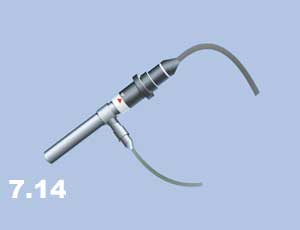Most laparoscopic instruments have finger ring or pistol grips, and are generally handled similar to standard surgical instruments.
General Principles:
a) Two-Handed Technique. It is at least as important in laparoscopic as in open surgery for the surgeon to use both hands simultaneously. The principle of traction and counter-traction requires constant repositioning of the non-dominant hand.
b) Camera Operator. This critical member of the laparoscopic team functions as the surgeons’ eyes. A good camera person is essential for consistent visualization throughout the procedure. The structure or organ which the surgeon is manipulating should be kept in the centre of the screen. If the surgeon is satisfied with the view, the camera should be kept still. Any camera movements should be small, and should be made slowly and smoothly, in order to avoid inducing motion sickness in those watching the monitor. The black cord coming off the end of the camera sets the “horizon” of the view, and therefore should always be kept down, toward the ground so that the surgeon remains oriented to the anatomy (Figure 7.14).

The gray light cord entering the side of the angled laparoscope adjusts the direction of the angle. The camera angle is always looking away from the cord.
c) Instrument Changes. These are time consuming and should be minimized. Novice laparoscopists should have their instruments escorted by the camera from the port to the target structure to be operated upon. Experienced laparoscopists can triangulate the ports in order to safely move the instrument in and out of the abdomen without moving the camera, except perhaps to zoom out slightly to view the inserted instrument. An important job of the assistant is to hold the cannula steady while the surgeon inserts the instrum
